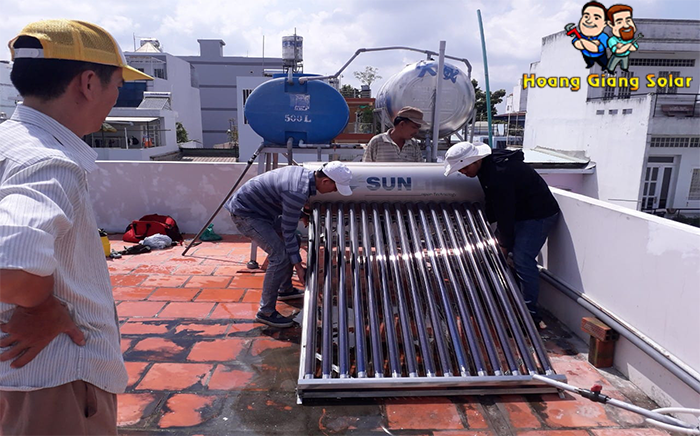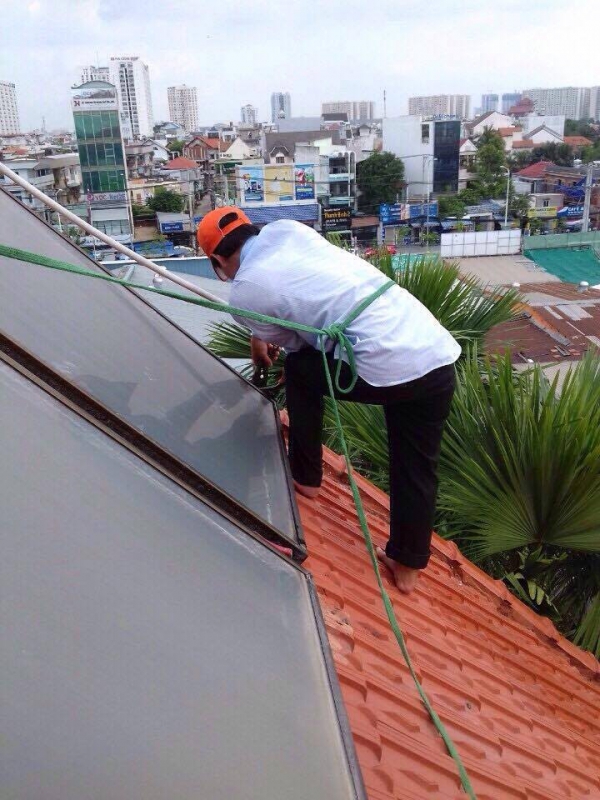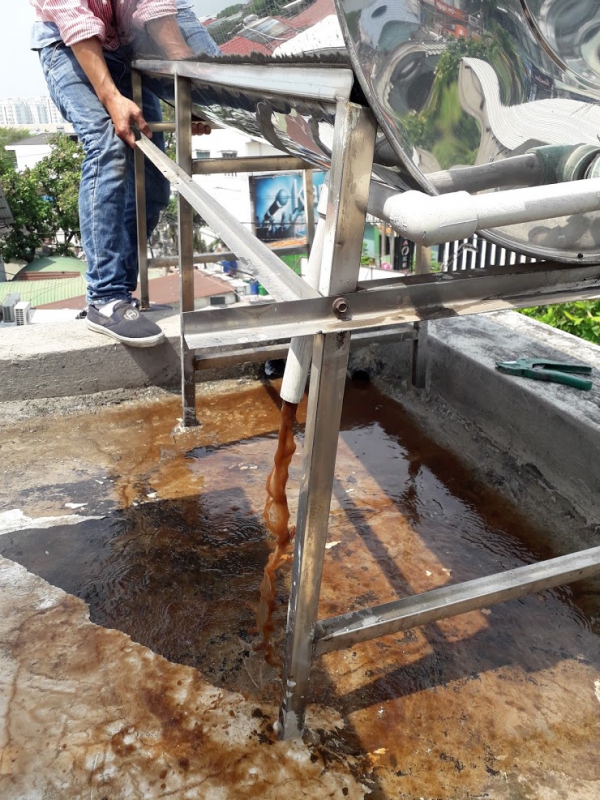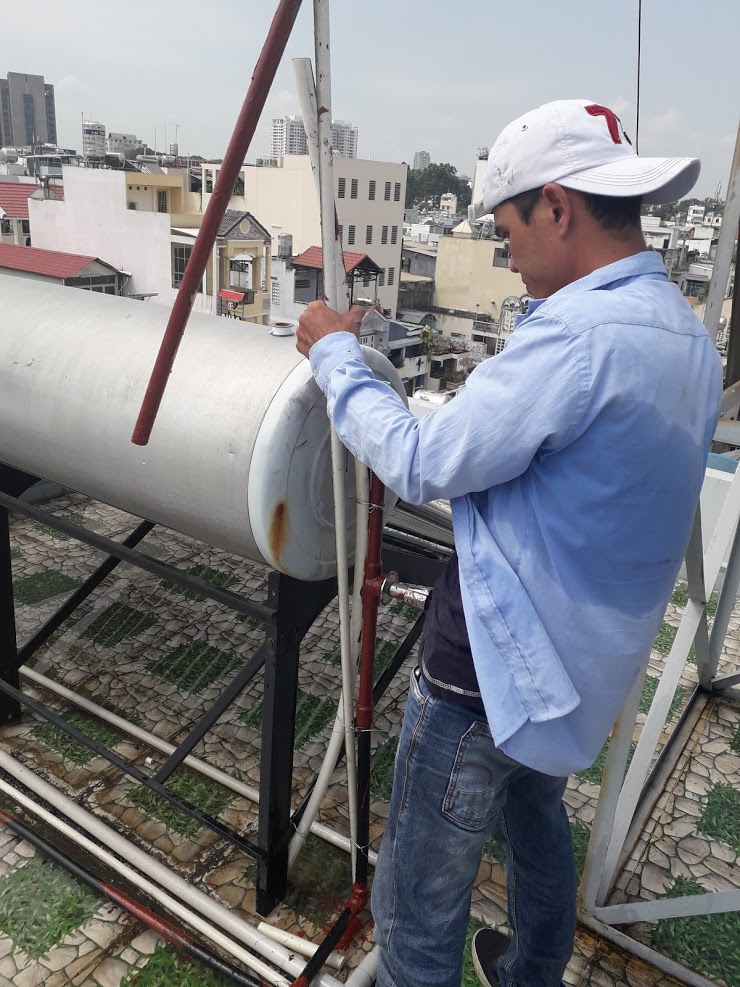Bán Máy Nước Nóng là nơi chuyên về cung cấp và sửa máy nước nóng năng lượng mặt trời uy tín nhất trong khu vực TPHCM. Với kinh nghiệm sửa chữa, thay thế và lắp đặt các hệ thống máy năng lượng mặt trời hơn 10 năm. Chúng tôi cung cấp cho khách hàng gói dịch vụ sửa chữa toàn diện nhất. Chuyên sửa chữa các lỗi từ nặng đến nhẹ của các hệ thống máy nước nóng năng lượng mặt trời.
Dịch vụ sửa máy nước nóng năng lượng mặt trời uy tín
Hiện nay máy nước nóng năng lượng mặt trời với những tính năng ưu việt, sử dụng nguồn tài nguyên thiên nhiên sẵn có đang ngày càng được sử dụng rộng rãi trên địa bàn TP Hồ Chí Minh và toàn quốc. Tuy nhiên trong quá trình sử dụng khó tránh khỏi những hư hỏng xảy ra do sự hao mòn của thiết bị và sự xâm hại của môi trường. Do đó, việc tìm kiếm một đơn vị chuyên sửa chữa chất lượng và uy tín là điều mà nhiều khách hàng quan tâm.
Liên hệ số điện thoại : 0909 638 569 – Website : https://hoanggiangsolar.com/
Đơn vị dẫn đầu trong lĩnh vực sửa máy nước nóng năng lượng
Bán máy nước nóng với kinh nghiệm lâu năm, dịch vụ chuyên nghiệp đã trở thành đơn vị dẫn đầu trong cung cấp, lắp đặt và sửa chữa tất cả các loại máy năng lượng mặt trời. Chúng tôi sở hữu các giải pháp toàn diện về thiết kế, thi công, sửa chữa mang đến cho khách hàng hệ thống máy nước nóng năng lượng mặt trời không chỉ bền đẹp, an toàn và dễ dàng sử dụng mà còn kéo dài tuổi thọ, tiết kiệm chi phí.
Chúng tôi với tiêu chí “uy tín và sự tận tâm làm nên thương hiệu” sau gần 10 năm hình thành và phát triển đã trở thành địa chỉ phân phối và sửa máy nước nóng năng lượng mặt trời tốt nhất trên thị trường hiện nay. Không dừng lại ở những thành công đã đạt được, chúng tôi còn chú trọng và không ngừng nâng cao chất lượng chuyên môn để phục vụ khách hàng ngày một tốt hơn với những dịch vụ thật hoàn hảo.
Bạn cần sửa máy năng lượng mặt trời khi
Máy nước nóng năng lượng mặt trời cũng như các thiết bị khác, sau thời gian dài sử dụng thường gặp phải những hư hỏng và sự cố. Nếu không kiểm tra bảo trì và sửa chữa kịp thời sẽ gây ảnh hưởng đến vận hành của máy cũng như sinh hoạt, cuộc sống trong ngôi nhà của bạn. Vì vậy, khi nhận thấy máy nước nóng xuất hiện những dấu hiệu sau đây bạn nên tiến hành sửa chữa:
- Máy nước nóng năng lượng mặt trời có hiện tượng xì nước.
- Nguồn nước từ máy khi thải ra có màu khác biệt, có mùi hôi khó chịu.
- Phụ kiện, đường ống dẫn nước gặp phải hư hỏng.
- Nước sử dụng không nóng.
- Ống thủy tinh năng lượng mặt trời rạn nứt, vỡ ống thủy tinh …
- Ron máy nước nóng năng lượng mặt trời lão hóa dẫn đến xì nước ở đầu ống thủy tinh, các ty cấp nước và thoát nước.
- Bình bảo ôn set rỉ, rò rỉ nước…
- Chân máy năng lượng gãy mục
- Đường ống nước nóng PPR lâu năm sẽ bị lão hóa, lủng ống…
- Nước nóng từ vòi sen, vòi tắm, lavabo không có nước hoặc chảy rất yếu
- Ống thông hơi có bị phun nước.




Khi nhận thấy những dấu hiệu hư hỏng trên bình nhưng không thể tự mình thực hiện công việc sửa chữa vì nhiều lý do, lúc này hãy chọn sử dụng dịch vụ sửa chữa máy nước nóng năng lượng mặt trời.
Chọn đơn vị nào sửa chữa máy nước nóng năng lượng mặt trời?
Có khá nhiều đơn vị cung cấp dịch vụ sửa chữa máy nước nóng năng lượng mặt trời. Tuy nhiên, nếu muốn thu được hiệu quả cao trong dịch vụ này nên tìm đến những đơn vị uy tín, được đông đảo khách hàng đánh giá cao. Chúng tôi tự hào là một trong những đơn vị hàng đầu Việt Nam cung cấp dịch vụ sửa chữa uy tín, đảm bảo lợi ích cho khách hàng tại Thành phố Hồ Chí Minh.
- Đơn vị nhận sửa chữa máy nước nóng năng lượng mặt trời gặp phải bất cứ sự cố nào.
- Nhận cung cấp linh kiện thay thế cho máy nước nóng đảm bảo hàng chính hãng. Nếu khách hàng phát hiện linh kiện giả, nhái kém chất lượng đơn vị sẵn sàng đền bù gấp đôi.
- Hỗ trợ sửa chữa máy tại nhà, có mặt chỉ sau 30 phút khi tiếp nhận yêu cầu của khách hàng.
- Cam kết kiểm tra và báo giá chính xác. Đồng thời khách hàng không cần động tay vào bất cứ công việc nào.
- Đội ngũ nhân viên tư vấn tận tình, với các lỗi nhỏ chắc chắn khách hàng có thể tự mình sửa chữa đơn vị sẽ đưa ra hướng dẫn giúp quý khách tiết kiệm chi phí.
- Sau khi tiếp nhận yêu cầu của khách hàng, chỉ sau 30 phút nhân viên kỹ thuật sẽ có mặt tận nơi kiểm tra và sửa chữa. Đồng thời nhân viên cam kết đề ra phương án sửa chữa nhanh chóng, tối ưu nhất giúp khách hàng tiết kiệm thời gian và chi phí.
- Xử lý triệt để những hư hỏng xuất hiện trên máy nước nóng năng lượng mặt trời. Đồng thời cung cấp chế độ bảo hành dài hạn cho khách hàng.
- Đơn vị còn hỗ trợ chế độ hậu mãi tốt, giảm lên tới 10% cho khách hàng cũ. Đặc biệt, Bán máy nước nóng thường xuyên đưa ra các chương trình khuyến mãi hấp dẫn mang đến những lợi ích cho khách hàng.
Quy trình làm việc
Dịch vụ sửa chữa máy nước nóng năng lượng mặt trời của chúng tôi được thực hiện dựa trên quy trình chuyên nghiệp. Điều đó được thể hiện chi tiết trong các bước sau:
Bước 1: Tiếp nhận yêu cầu khách hàng
Khi khách hàng có nhu cầu sử dụng dịch vụ vui lòng liên hệ với chúng tôi yêu cầu sử dụng dịch vụ. Đồng thời lắng nghe lời tư vấn của nhân viên để chọn được dịch vụ phù hợp nhất.
Bước 2: Kiểm tra và báo giá
Nhân viên khi tiếp nhận thông tin sẽ trực tiếp tới địa chỉ khách hàng kiểm tra mức độ hư hỏng. Sau khi tìm hiểu nguyên nhân sẽ đề ra phương án sửa chữa và báo giá dịch vụ.
Bước 3: Thực hiện sửa chữa
Bằng phương pháp nhanh nhất cùng những dụng cụ đồ nghề chuẩn bị sẵn, nhân viên thực hiện bước sửa chữa máy nước nóng năng lượng mặt trời.
Bước 4: Nghiệm thu và bảo hành
Sau khi báo hoàn tất quá trình sửa chữa, nhân viên đơn vị cùng khách hàng sẽ nghiệm thu. Tiếp đến nhân viên cung cấp phiếu bảo hành, khách hàng thanh toán tiền cho nhân viên.
TẠI SAO NÊN CHỌN CHÚNG TÔI?
Chúng tôi không hoàn thành cho đến khi bạn hài lòng. Có lẽ đó là lý do tại sao rất nhiều người hàng xóm của bạn cho chúng tôi đánh giá địa phương năm sao.
THỜI GIAN SỬA CHỮA
24h/7 chúng tối luôn hân hạnh được phục vụ quý khách. Sữa chữa kịp thời linh động với mọi nhu cầu của khách hàng. Nơi nào cần sẽ có mặt của chúng tôi.
CHÍNH SÁCH BẢO HÀNH
Bảo hành với mọi thiết bị lắp đặt từ chúng tôi. Bảo hành theo chính sách linh hoạt nhất giúp thiết bị của khách hàng vận hành trơn tru. Không một lỗi lầm dù là nhỏ nhất.
Với quy trình sửa máy năng lượng mặt trời chuyên nghiệp và hiệu quả mang lại, tất cả các lỗi hư hỏng đều sử lý sửa chữa kịp thời. Vì thế, chúng tôi tự hào là một trong những người bạn, đơn vị đồng hành thân thiết cho quý khách trên toàn khu vực Thành Phố Hồ Chí Minh, Bình Dương, Đồng Nai..Sửa chữa máy nước nóng năng lượng mặt trời từ Bán Máy Nước Nóng mang đến khách hàng nhiều lợi ích, cùng quy trình thực hiện chuyên nghiệp nhất. Liên hệ ngay với chúng tôi để sở hữu dịch vụ chất lượng quý khách nhé. Với nhiều năm kinh nghiệm trong lĩnh vực này, đơn vị chúng tôi cam kết không làm khách hàng thất vọng.
Hotline hoặc Zalo : 0909638569 Để tiết kiệm thời gian nhất, Quý khách cũng có thể gởi ảnh qua zalo để chúng tôi tư vấn kiểm tra báo giá online một cách nhanh nhất.

